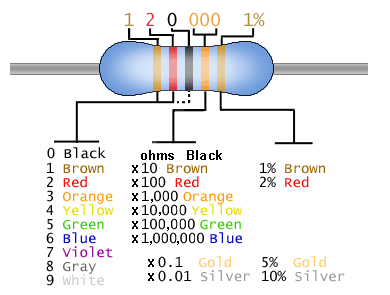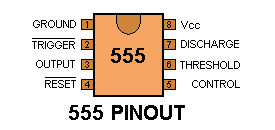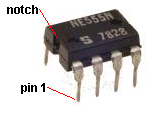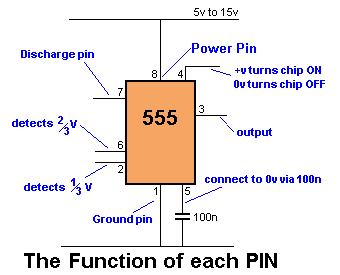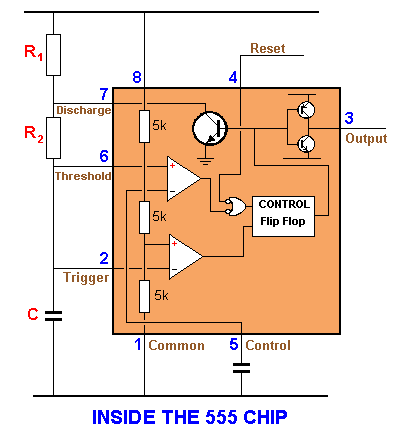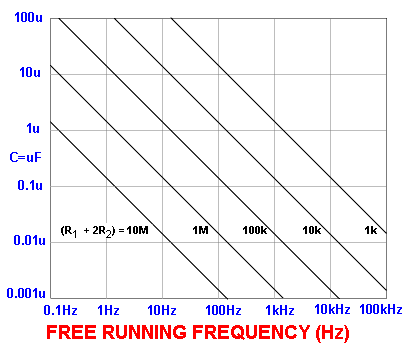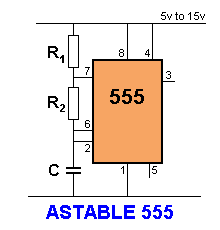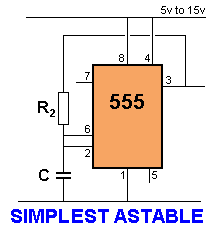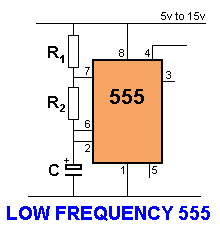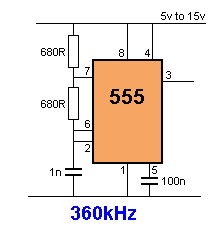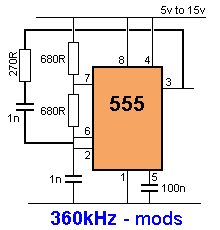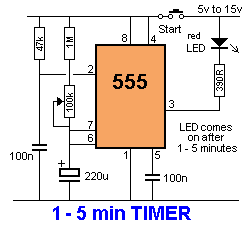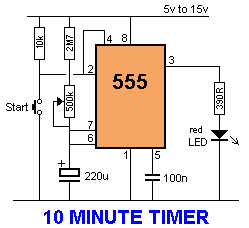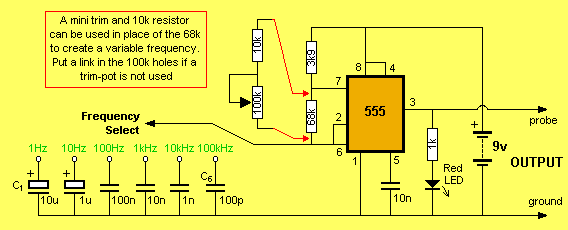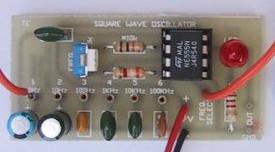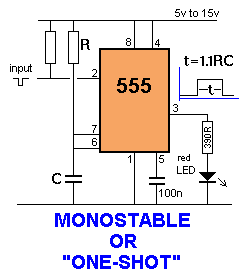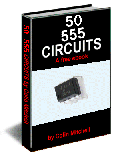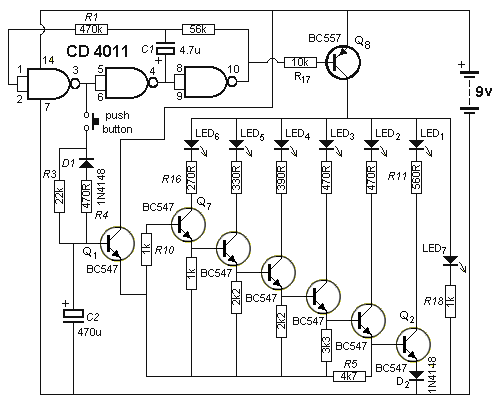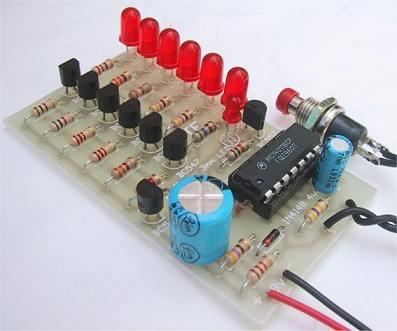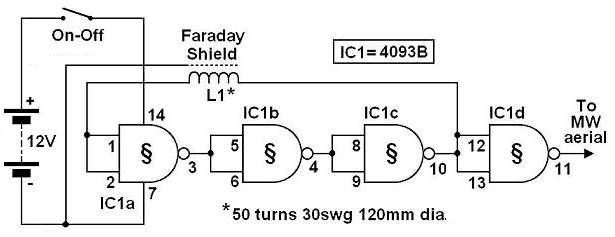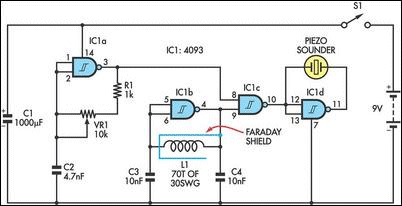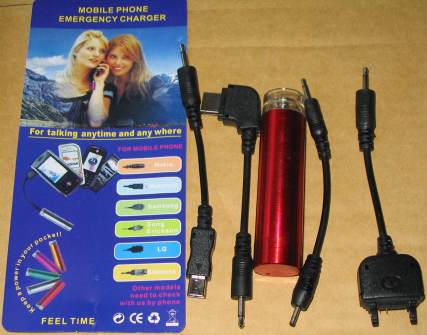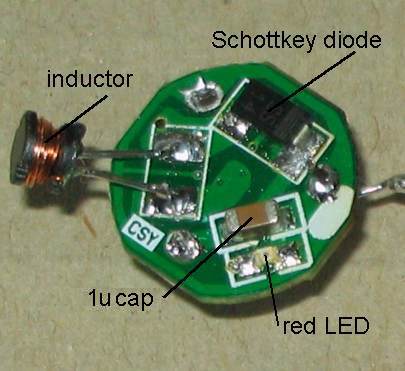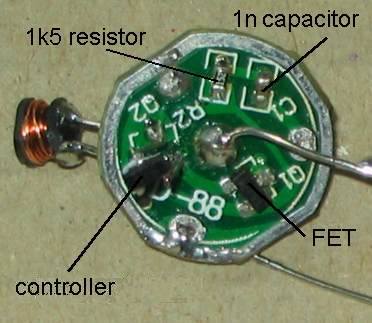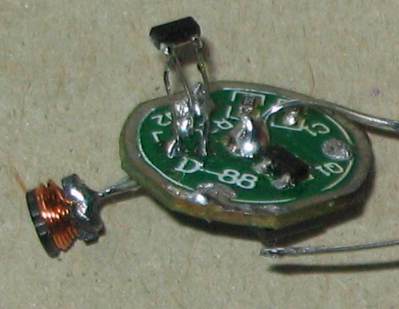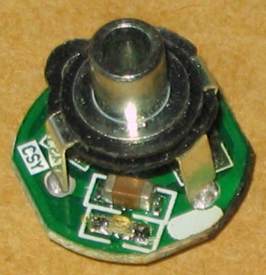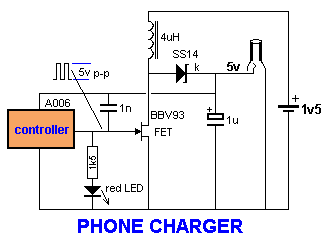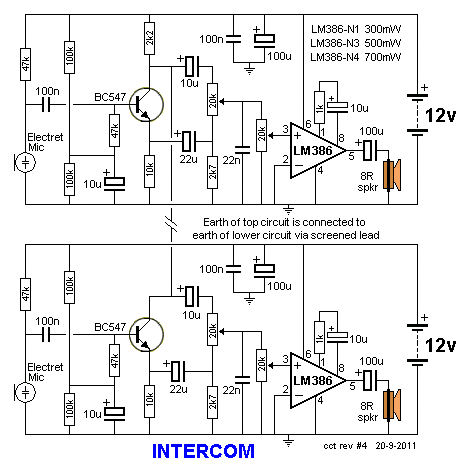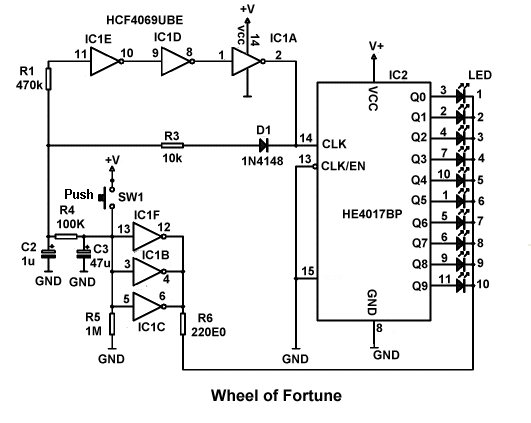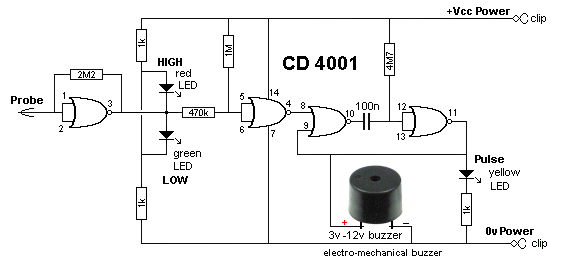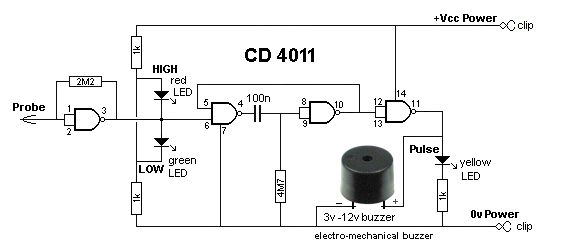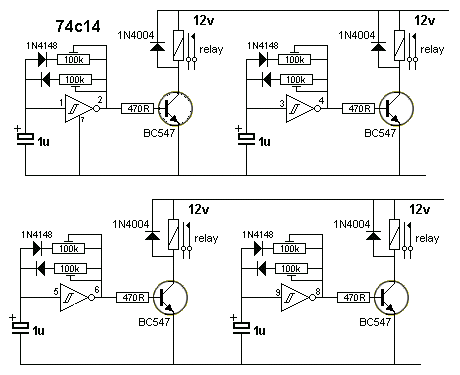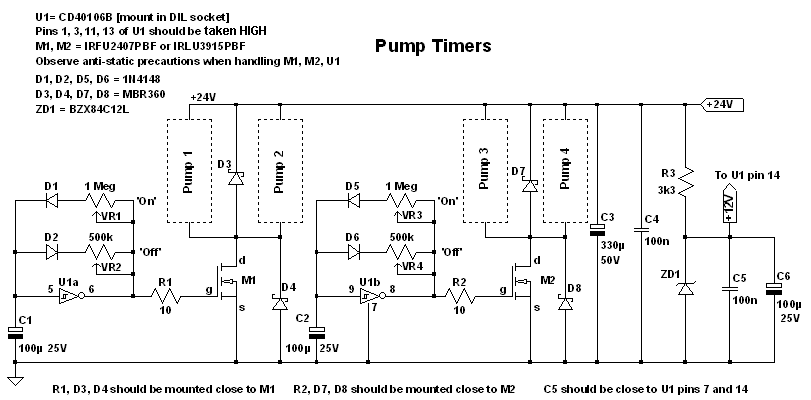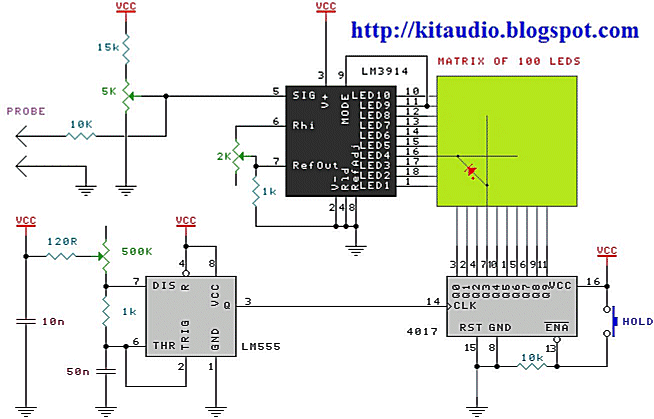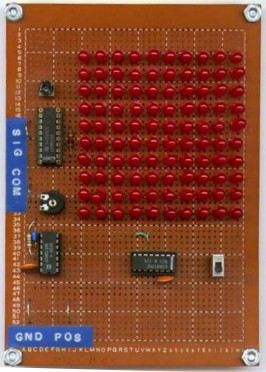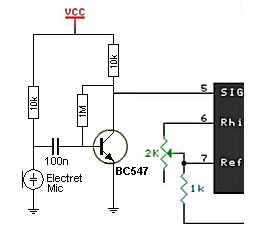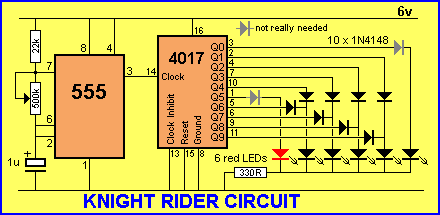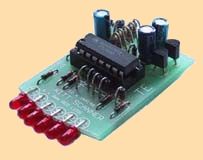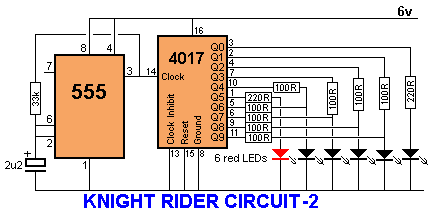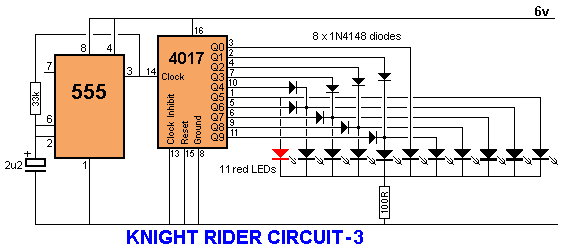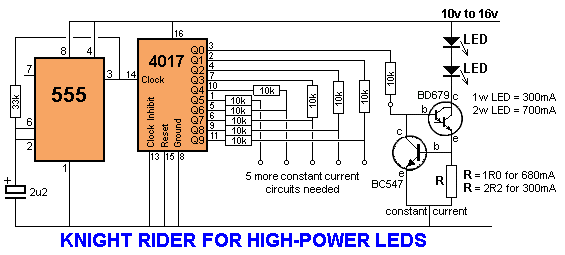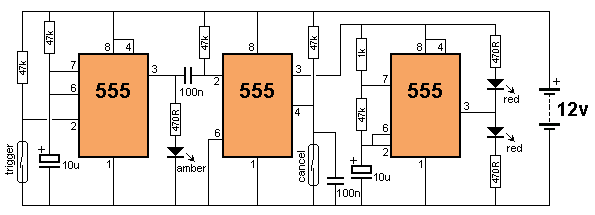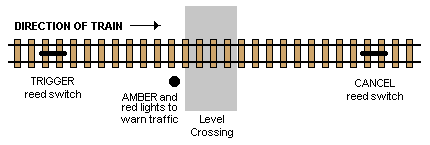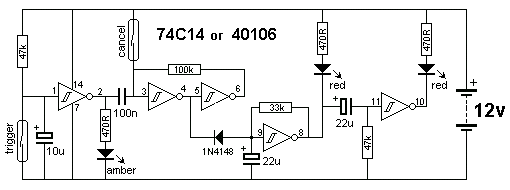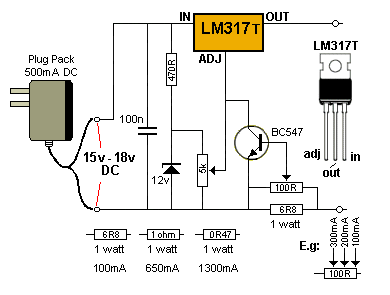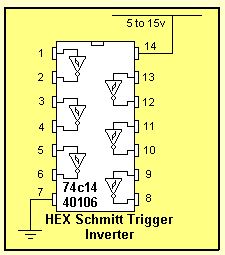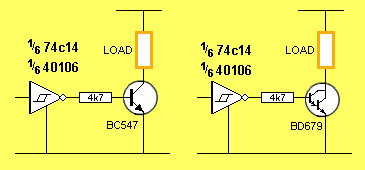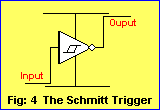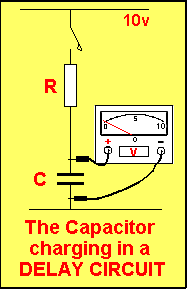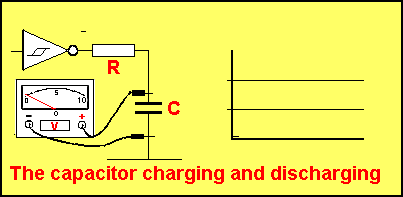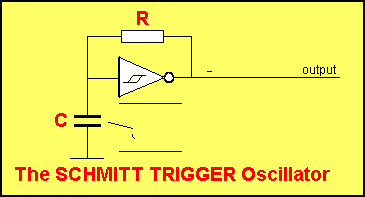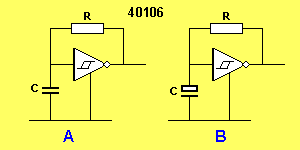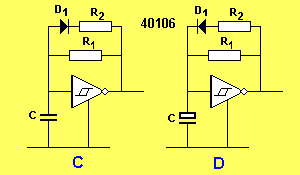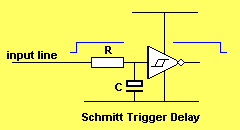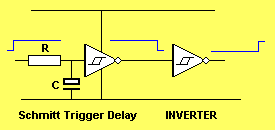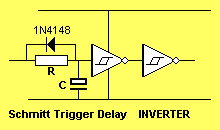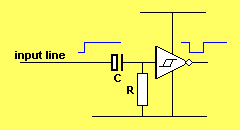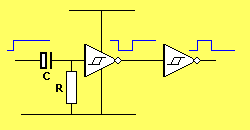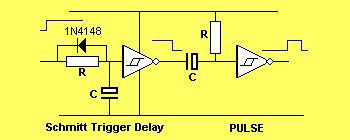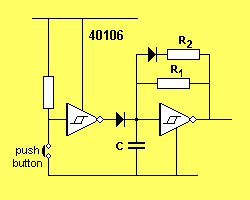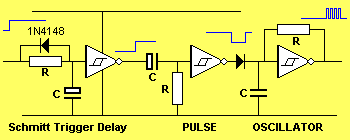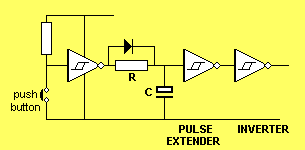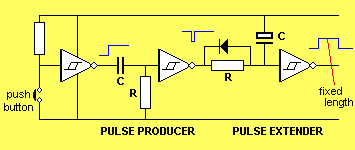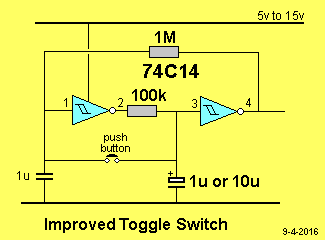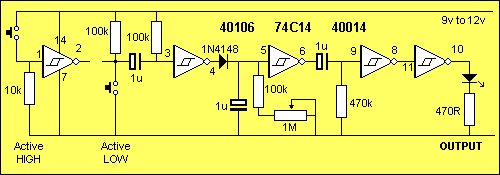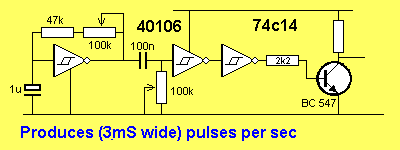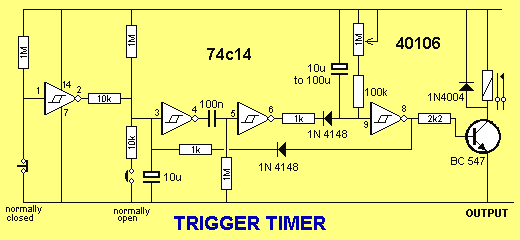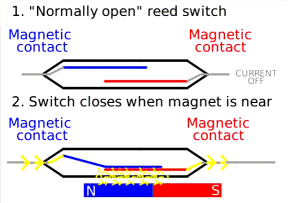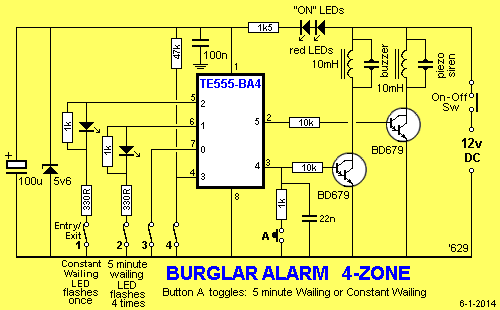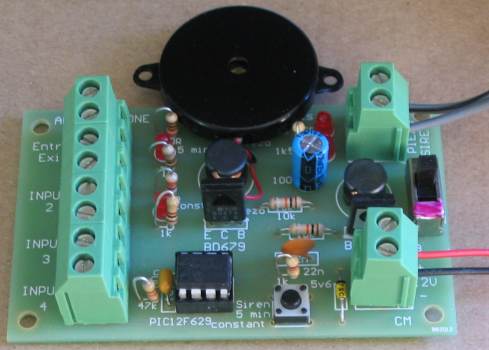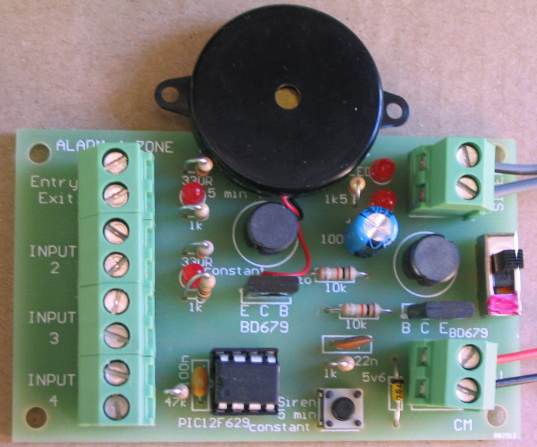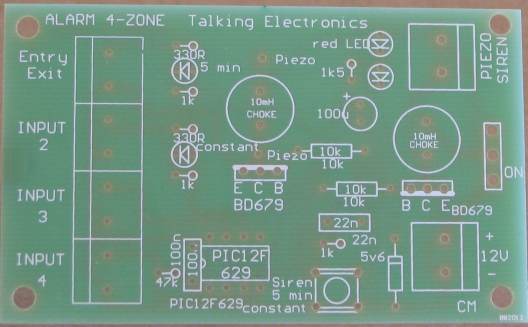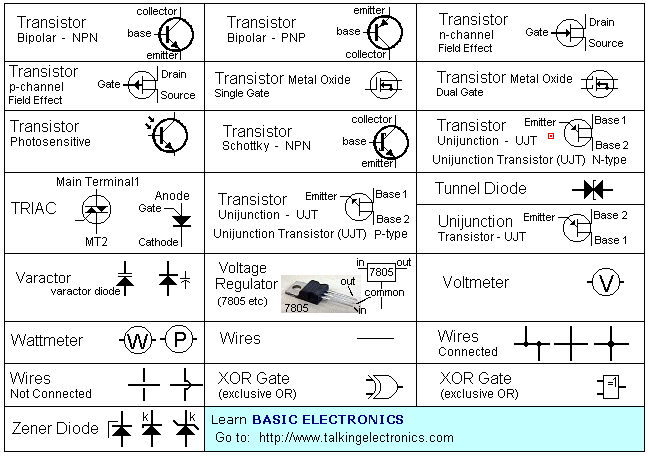INTEGRATED CIRCUITS
19/12/2012 14:44
INTRODUCTION
This is the third part of our Circuits e-book series. It contains a further 100 circuits. This time we have concentrated on circuits containing one or more IC's.
It's amazing what you can do with transistors but when Integrated Circuits came along, the whole field of electronics exploded.
IC's can handle both analogue as well as digital signals but before their arrival, nearly all circuits were analogue or very simple "digital" switching circuits.
Let's explain what we mean.
The word analogue is a waveform or signal that is changing (increasing and decreasing) at a constant or non constant rate. Examples are voice, music, tones, sounds and frequencies. Equipment such as radios, TV's and amplifiers process analogue signals.
Then digital came along.
Digital is similar to a switch turning something on and off.
The advantage of digital is two-fold.
Firstly it is a very reliable and accurate way to send a signal. The signal is either HIGH or LOW (ON or OFF). It cannot be half-on or one quarter-off.
And secondly, a circuit that is ON, consumes the least amount of energy in the controlling device. In other words, a transistor that is fully turned ON and driving a motor, dissipates the least amount of heat. If it is slightly turned ON or nearly fully turned ON, it gets very hot.
And obviously a transistor that is not turned on at all will consume no energy.
A transistor that turns ON fully and OFF fully is called a SWITCH.
When two transistors are cross-coupled in the form of a flip flop, any pulses entering the circuit cause it to flip and flop and the output goes HIGH on every second pulse. This means the circuit halves the input pulses and is the basis of counting or dividing. It is also the basis of a "Memory Cell" as will will hold a piece of information.
Digital circuits also introduce the concept of two inputs creating a HIGH output when both are HIGH and variations of this.
This is called "logic" and introduces terms such as "Boolean algebra" (Boolean logic) and "gates."
Integrated Circuits started with a few transistors in each "chip" and increased to mini or micro computers in a single chip. These chips are called Microcontrollers and a single chip with a few surrounding components can be programmed to play games, monitor heart-rate and do all sorts of amazing things. Because they can process information at high speed, the end result can appear to have intelligence and this is where we are heading: AI (Artificial Intelligence).
In this IC Circuits ebook, we have presented about 100 interesting circuits using Integrated Circuits.
In most cases the IC will contain 10 - 100 transistors, cost less than the individual components and take up much less board-space. They also save a lot of circuit designing and quite often consume less current than discrete components or the components they replace.
In all, they are a fantastic way to get something working with the least componentry.
A list of of some of the most common Integrated Circuits (Chips) is provided at the end of this book to help you identify the pins and show you what is inside the chip.
Some of the circuits are available from Talking Electronics as a kit, but others will have to be purchased as individual components from your local electronics store. Electronics is such an enormous field that we cannot provide kits for everything. But if you have a query about one of the circuits, you can contact me.
Colin Mitchell
TALKING ELECTRONICS.
talking@tpg.com.au
To save space we have not provided lengthy explanations of how the circuits work. This has already been covered in TALKING ELECTRONICS Basic Electronics Course, and can be obtained on a CD for $10.00 (posted to anywhere in the world) See Talking Electronics website for more details: https://www.talkingelectronics.com
MORE INTRO
We have said this before abut we will say it again: There are two ways to learn electronics.
One is to go to school and study theory for 4 years and come out with all the theoretical knowledge in the world but very little practical experience. The other is to "learn on the job."
I am not saying one approach is better than the other but most electronics enthusiasts are not "book worms" and many have been dissuaded from entering electronics due to the complex mathematics surrounding University-type courses.
Our method is to get around this by advocating designing, building, constructions and even more assembly with lots of experimenting and when you get stuck with a mathematical problem, get some advice or read about it via the thousands of free test books on the web.
Anyone can succeed in this field by applying themselves to constructing projects. You actually learn 10 times faster by doing it yourself and we have had lots of examples of designs from students in the early stages of their career.
And don't think the experts get it right the first time. Look at all the recalled electronics equipment from the early days.
The most amazing inventions have come from almost "newcomers" as evidenced by looking through the "New Inventions" website.
All you have to do is see a path for your ideas and have a goal that you can add your ideas to the "Word of Invention" and you succeed.
Nothing succeeds like success. And if you have a flair for designing things, electronics will provide you a comfortable living for the rest of your life.
The market is very narrow but new designs are coming along all the time and new devices are constantly being invented and more are always needed.
Once you get past this eBook of "Chips" you will want to investigate microcontrollers and this is when your options will explode.
You will be able to carry out tasks you never thought possible, with a chip as small as 8 pins and a few hundred lines of code.
In two weeks you can start to understand the programming code for a microcontroller and perform simple tasks such as flashing a LED and produce sounds and outputs via the press of a button.
All these things are covered on Talking Electronics website and you don't have to buy any books or publications. Everything is available on the web and it is instantly accessible. That's the beauty of the web.
Don't think things are greener on the other side of the fence, by buying a text book. They aren't. Everything you need is on the web AT NO COST.
The only thing you have to do is build things. If you have any technical problem at all, simply email Colin Mitchell and any question will be answered. Nothing could be simpler and this way we guarantee you SUCCESS. Hundreds of readers have already emailed and after 5 or more emails, their circuit works. That's the way we work. One thing at a time and eventually the fault is found.
If you think a circuit will work the first time it is turned on, you are fooling yourself.
All circuits need corrections and improvements and that's what makes a good electronics person. Don't give up. How do you think all the circuits in these eBooks were designed? Some were copied and some were designed from scratch but all had to be built and adjusted slightly to make sure they worked perfectly.
I don't care if you use bread-board, copper strips, matrix board or solder the components in the air as a "bird's nest." You only learn when the circuit gets turned on and WORKS!
In fact the rougher you build something, the more you will guarantee it will work when built on a printed circuit board.
However, high-frequency circuits (such as 100MHz FM Bugs) do not like open layouts and you have to keep the construction as tight as possible to get them to operate reliably.
In most other cases, the layout is not critical.
If you just follow these ideas, you will succeed.
A few of the basics are also provided in this eBook, the first is transistor outlines:
TRANSISTORS
Most of the transistors used in our circuits are BC 547 and BC 557. These are classified as "universal" or "common" NPN and PNP types with a voltage rating of about 25v, 100mA collector current and a gain of about 100.
You can use almost any type of transistor to replace them and here is a list of the equivalents and pinouts:
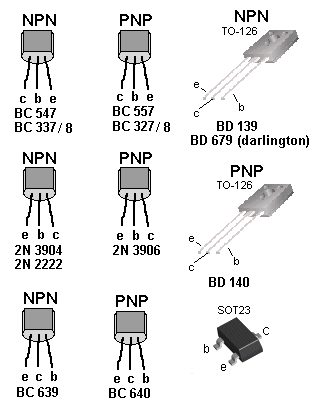
![]()
|
RESISTOR COLOUR CODE
|
See resistors from 0.22ohm to 22M in full colour at end of book and another resistor table ![]()
|
THE 555
Using the graph:
555 ASTABLE OSCILLATORS
SQUARE WAVE OSCILLATOR
|
|||||||||||||||||||||||||||||||||||||||||||||||||||||||||||||
|
50 - 555 CIRCUITS
|
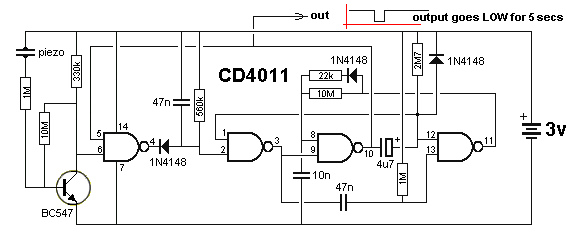 KNOCK KNOCK DOORBELL This very clever circuit only produces an output when the piezo detects two taps. It can be used as a knock-knock doorbell. A PC board containing all components (soldered to the board) is available from talking electronics for $5.00 plus postage. Email HERE for details. The circuit takes only a few microamp and when a tap is detected by the piezo, the waveform from the transistor produces a HIGH on pin 6 and the HIGH on pin 5 makes output pin 4 go low. This very quickly charges the 47n and it is discharged via the 560k to produce a brief pulse at pin 3. The 47n is mainly to stop noise entering pin 2. Pin 1 is HIGH via the 2M7 and the LOW on pin 2 causes pin 3 to produce a HIGH pulse. The 47n is discharged via the internal diodes on pin 13 and when it goes LOW, pin 11 goes HIGH and charges the 10n via the 22k and diode. This puts a HIGH on pin 8 for approx 0.7 seconds and when a second tap is detected, pin 9 sees a HIGH and pin 10 goes LOW. This puts a LOW on pin 12 and a HIGH on pin 8. The LOW on pin 12 goes to pin 1. A HIGH and LOW on the second NAND gate produces a HIGH on pin 3 and the third NAND gate has a HIGH on both inputs. This makes pin 10 LOW and the 4u7 starts to charge via the 2M7 resistor. After 5 seconds pin 12 sees a HIGH and pin 11 goes LOW. The 10n is discharged via the 10M and when pin 8 sees a LOW, pin 10 goes HIGH. The output sits HIGH and goes LOW for about 7 seconds. |
|
LED ZEPPELIN |
|
BFO METAL DETECTOR
|
|
SIMPLE BFO METAL LOCATOR
|
|
1.5v to 5v PHONE CHARGER
|
|
10 SECOND ALARM This circuit is activated for 10 seconds via the first two gates. They form a LATCH to keep the oscillator (made up of the next two gates) in operation, to drive the speaker. The circuit consumes a few microamps in quiescent mode and the TOUCH PLATES can be any type of foil on a door knob or item that is required to be protected. The 10u sits in an uncharged condition and when the plates are touched, the voltage on pin 1 drops below 50% rail and makes pin 3 HIGH. This pulls pins 5 and 6 HIGH and makes pin 4 LOW. This keeps pin 3 HIGH, no matter if a HIGH or LOW is on pin1. This turns on the oscillator and the 10u starts to charge via the 100k resistor. After about 10 seconds, the voltage on pins 5 and 6 drops to below 50% rail voltage and pin 4 goes HIGH. If the TOUCH PLATES are not touched, pin 3 will go LOW and the oscillator will stop. 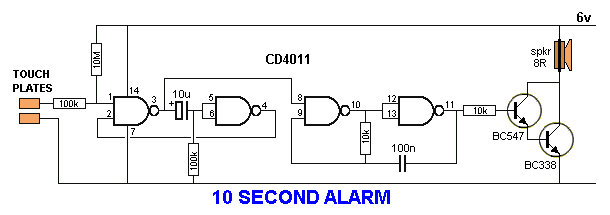 |
|
USING A VOLTAGE REGULATOR This circuit shows how to use a voltage regulator to convert a 24v supply to 12v for a 555 chip. Note: the pins on the regulator (commonly called a 3-terminal regulator) are: IN, COMMON, OUT and these must match-up with: In, Common, Out on the circuit diagram. If the current requirement is less than 500mA, a 100R "safety resistor" can be placed on the 24v rail to prevent spikes damaging the regulator. 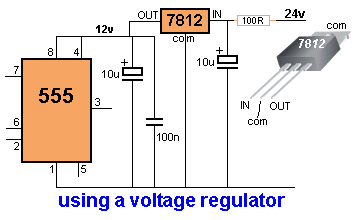 |
|
POLICE LIGHTS These three circuits flash the left LEDs 3 times then the right LEDs 3 times, then repeats. The only difference is the choice of chips. 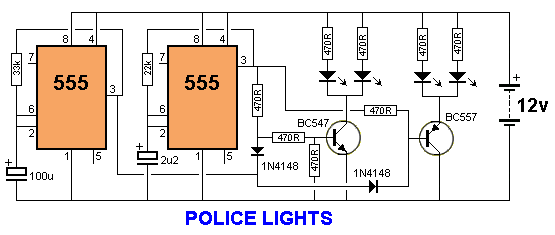 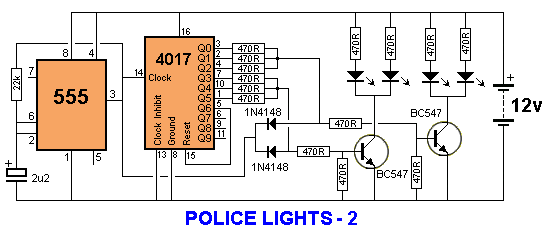 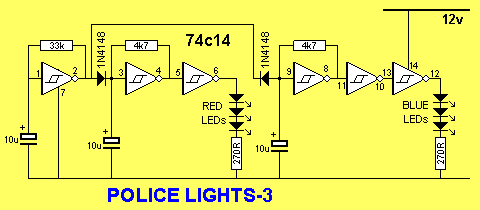 |
|
FLASH LEDS FOR 20 SECONDS This circuit comes from a request from a reader. It flashes a LED for 20 seconds after a switch is pressed. In other words, for 20 seconds as soon as the switch is pressed. The values will need to be adjusted to get the required flash-rate and timing. 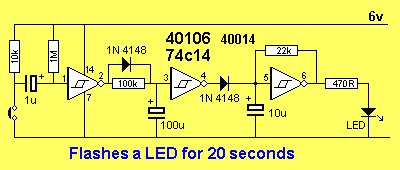 |
|
INTERCOM
This circuit uses a single transistor and LM386 amplifier IC to produce an intercom that allows hands-free operation.
As both microphones and loudspeakers are always connected, the circuit is designed to avoid feedback - known as the "Larsen effect". The microphone amplifier transistor is 180° phase-shifted and one of the audio outputs is taken at the collector and its in-phase output taken at the emitter. These are mixed by the 10u, 22u, 20k pot and 2k7 so that the two signals almost cancel out. In this way, the loudspeaker will reproduce a very faint copy of the signals picked-up by the microphone. At the same time, as both collectors of the two intercom units are tied together, the 180° phase-shifted signal will pass to the audio amplifier of the second unit without attenuation, so it will be loudly reproduced by its loudspeaker. The same operation will occur when speaking into the microphone of the second unit. When the 20k pot is set correctly, almost no output will be heard from the loudspeaker but a loud and clear reproduction will be heard at the output of the other unit. The second 20k pot adjusts the volume. |
|
ACTIVATE VIA 3 PHONE RINGS
This circuit connects to a phone line. When the phone rings for 3 or 4 rings, the relay is activated for about 1 minute. But if the phone rings for 6 or more rings, the circuit is not activated.
|
|
WATER LEVEL PUMP CONTROLLER
This circuit provides automatic level control of a water tank.
The shorter steel rod is the "water high" sensor and the longer is the "water low" sensor. When the water level is below both sensors, pin 10 is low. If the water comes in contact with the longer sensor the output remains low until the shorter sensor is reached. At this point pin11 goes high and the transistor conducts. The relay is energized and the pump starts operating. When the water level drops the shorter sensor will be no longer in contact with the water, but the output of the IC will keep the transistor tuned ON until the water falls below the level of the longer rod. When the water level falls below the longer sensor, the output of the IC goes low and the pump will stop. The switch provides reverse operation. Switching to connect the transistor to pin 11 of the IC will cause the pump will operate when the tank is nearly empty and will stop when the tank is full. In this case, the pump will be used to fill the tank and not to empty it. Note: The two steel rods must be supported by a small insulated (wooden or plastic) board. The circuit can be used also with non-metal tanks, provided a third steel rod having about the same height as the tank is connected to the negative. Adding an alarm to pin 11 will let you know the tank is nearly empty. 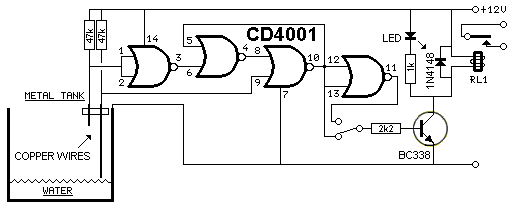 |
|
BRAKE LIGHTS
This circuit makes the brake lights flash a number of times then stay ON. The circuit shows how a MOSFET works. The MOSFET is turned on with a voltage between the gate and source. This occurs in the circuit when the gate is LOW. The P-channel MOSFET can be replaced by a PNP transistor with the addition of a 2k2 between the diode and base, to prevent the transistor being damaged when output pin 3 goes LOW. Ideally the PNP transistor should be replaced with a Darlington transistor.
This circuit originally designed by: Ken Moffett Scientific Instrumentation Macalester College 1600 Grand Avenue St Paul MN 55105 moffett@macalester.edu See the full article: https://www.sentex.net/~mec1995/circ/motflash.html .pdf of article  |
|
ACTIVE FOR 1 SECOND
This circuit is active for 1 second after it detects a signal on the base of the input transistor. The length of activation depends on the value of the resistor across the 10u electrolytic.
|
|
THE DOMINO EFFECT
Here's a project with an interesting name. The original design was bought over 40 years ago, before the introduction of the electret microphone. They used a crystal earpiece.
We have substituted it with a piezo diaphragm and used a quad op-amp to produce two building blocks. The first is a high-gain amplifier to take the few millivolts output of the piezo and amplify it sufficiently to drive the input of a counter chip. This requires a waveform of at least 6v for a 9v supply and we need a gain of about 600. The other building block is simply a buffer that takes the high-amplitude waveform and delivers the negative excursions to a reservoir capacitor (100u electrolytic). The charge on this capacitor turns on a BC557 transistor and this effectively takes the power pin of the counter-chip to the positive rail via the collector lead. The chip has internal current limiting and some of the outputs are taken to sets of three LEDs. The chip is actually a counter or divider and the frequency picked up by the piezo is divided by 128 and delivered to one output and divided by over 8,000 by the highest-division output to three more LEDs The other lines have lower divisions. This creates a very impressive effect as the LEDs are connected to produce a balanced display that changes according to the beat of the music. The voltage on the three amplifiers is determined by the 3M3 and 1M voltage-divider on the first op-amp. It produces about 2v. This makes the output go HIGH and it takes pin 2 with it until this pin see a few millivolts above pin3. At this point the output stops rising. Any waveform (voltage) produced by the piezo that is lower than the voltage on pin 3 will make the output go HIGH and this is how we get a large waveform. This signal is passed to the second op-amp and because the voltage on pin 6 is delayed slightly by the 100n capacitor, is also produces a gain. When no signal is picked up by the piezo, pin 7 is approx 2v and pin 10 is about 4.5v. Because pin 9 is lower than pin 10, the output pin 8 is about 7.7v (1.3v below the supply rail) as this is as high as the output will go - it does not go full rail-to-rail. The LED connected to the output removes 1.7v, plus 0.6v between base and emitter and this means the transistor is not turned on. Any colour LEDs can be used and a mixture will give a different effect. Click the link above for more details on the project, including photos and construction notes. 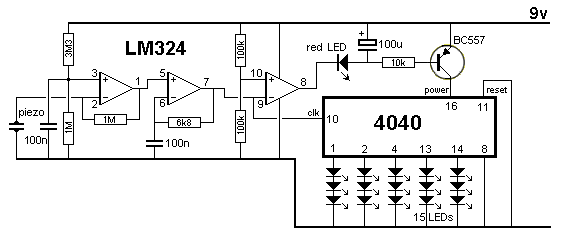 |
|
10 LED CHASER
Here's an interesting circuit that creates a clock pulse for a 4017 from a flashing LED. The flashing LED takes almost no current between flashes and thus the clock line is low via the 1k to 22k resistor. When the LED flashes, the voltage on the clock line is about 2v -3v below the rail voltage (depending on the value of the resistor) and this is sufficient for the chip to see a HIGH.
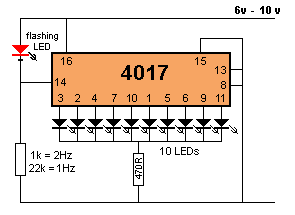 (circuit designed on 9-10-2010) |
|
WHEEL OF FORTUNE
|
|
TRANSISTOR TESTER COMBO-2
The circuit uses a single IC to perform 3 tests: Test 1: Place the transistor in any orientation into the three terminals of circuit 1 (below, left) and a red LED will detect the base of a PNP transistor an a green LED will indicate the base of an NPN transistor. Test 2: You now now the base lead and the type of transistor. Place the transistor in Test 2 circuit (top circuit) and when you have fitted the collector and emitter leads correctly (maybe have to swap leads), the red or green LED will come on to prove you have fitted the transistor correctly. Test 3: The transistor can now be fitted in the GAIN SECTION. Select PNP or NPN and turn the pot until the LED illuminates. The value of gain is marked on the PCB that comes with the kit. The kit has ezy clips that clip onto the leads of the transistor to make it easy to use the project. The project also has a probe at one end of the board that produces a square wave - suitable for all sorts of audio testing and some digital testing. Project cost: $22.00 from Talking Electronics. 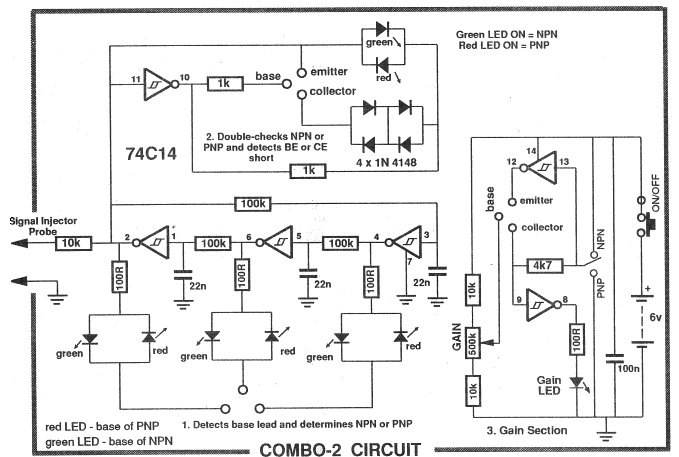 |
|
GELL CELL BATTERY CHARGER
This circuit will charge gell cell batteries at 300mA or 650mA or 1.3A, depending on the CURRENT SENSING resistor in the 0v rail. Adjust the 5k pot for 13.4v out and when the battery voltage reaches this level, the current will drop to a few milliamps. The plug pack will need to be upgraded for the 650mA or 1.3A charge-current. The red LED indicates charging and as the battery voltage rises, the current-flow decreases. The maximum is shown below and when it drops about 5%, the LED turns off and the current gradually drops to almost zero.
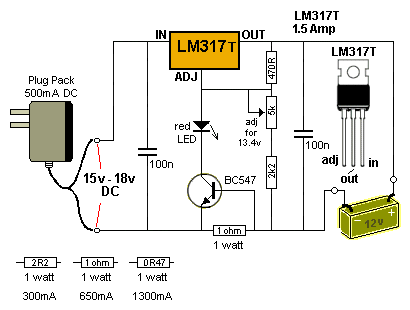 |
|
SIMPLE LOGIC PROBE
|
10 MINUTE AND 30 MINUTE TIMER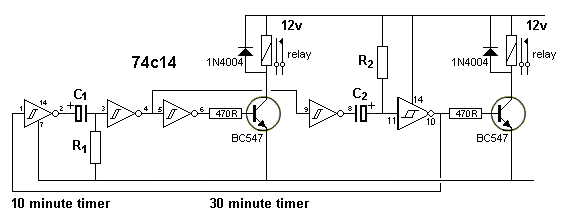 This circuit turns on the first relay for any period of time as determined by the value of C1 and R1. When relay 1 turns off, relay 2 turns ON for any period of time as determined by C2 and R2. When relay 2 turns off, relay 1 turns ON and the cycle repeats. |
|
4 PUMPS
|
|
LONG DURATION TIMER
To get a long duration timer we can create an oscillator, called a CLOCK OSCILLATOR, and feed it to a number of flip-flops. A flip-flop is a form of bi-stable multivibrator, wired so an input signal will change the output on every second cycle. In other words it divides (halves) the input signal. When two of these are connected in a "chain" the input signal divides by 4. The CD4060 IC has 14 stages. These are also called BINARY DIVIDERS and the chip is also called a COUNTER.
The IC also has components (called gates or inverters) on pins 9,10 and 11 that can be wired to produce an oscillator. Three external components are needed to produce the duration of the oscillations. In other words the frequency of the "clock signal." The output of the oscillator is connected (inside the chip) to the Binary Dividers and each stage goes HIGH then LOW due to the signal it is receiving. Each stage rises and falls at a rate that is half the previous stage and the final stage provides the long time delay as it takes 213 clock cycles before going HIGH. We have only taken from Q10 in this circuit and the outline of the chip has been provided in the circuit so different outputs can be used to produce different timings. The diode on the output "jams" the oscillator and stops it operating so the relay stays active when the time has expired. 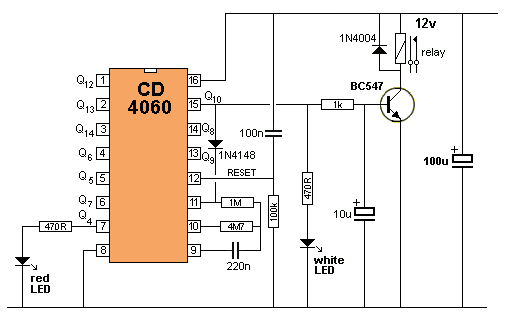 |
|
LADYBUG ROBOT
Ladybug Robot moves with its six legs and makes use of infrared emitting diodes as its eyes to avoid obstacles along its path. Ladybug automatically makes a left turn the moment it detects an object in its path. It continues to move forward again when no obstacle is in the way.
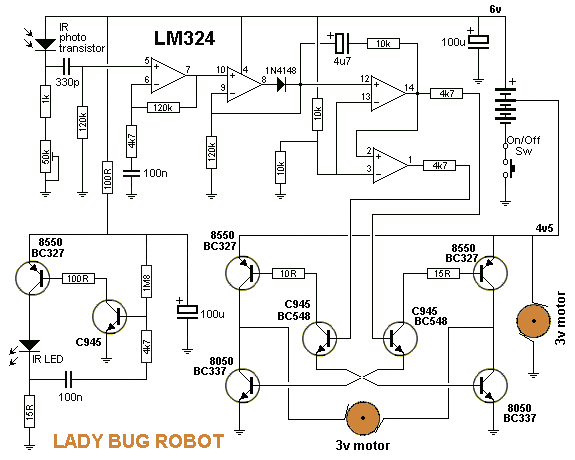 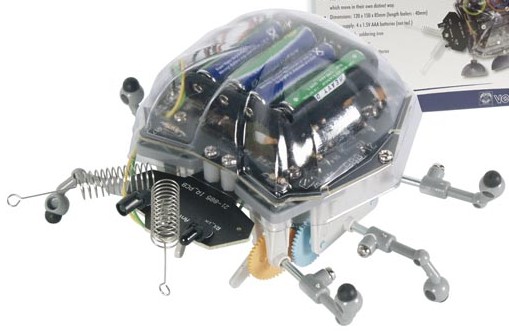 See Hex Bug in "200 Transistor Circuits" for a transistor version of this circuit. |
|
100 LED CRO
|
|
PHONE RINGER This circuit shows how a very complex set of pulses can be produced via a very simple circuit. The CD4060B IC produce three kinds of pulses. Preset VR1 is fine-tuned to get 0.3125Hz pulses at pin 3 of IC1. At the same time, pulses obtainable from pin 1 will be of 1.25 Hz and 20 Hz at pin 14. The three output pins of IC1 are connected to base terminals of transistors T1, T2, and T3 through resistors R1, R2, and R3, respectively. Working with a built-in oscillator-type piezo buzzer generates about 1kHz tone. In this particular circuit, the piezo-buzzer is turned ‘on’ and ‘off’ at 20 Hz for ring tone sound by transistor T3. 20Hz pulses are obtainable at the collector of transistor T3 for 0.4-second duration. Just after a time interval of 0.4 second, 20Hz pulses become again obtainable for another 0.4-second duration. This is followed by two seconds of no sound interval. Thereafter the pulse pattern repeats by itself. 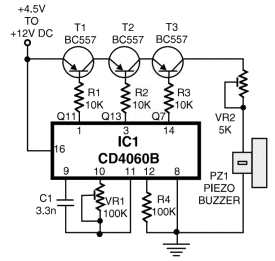 |
|
KNIGHT RIDER
This circuit drives 11 LEDs with a cross-over effect:
KNIGHT RIDER FOR HIGH-POWER LEDS (constant current) |
![]() to Index >
to Index >
|
CROSSING LIGHTS
The circuit can also be constructed with a 40106 HEX Schmitt trigger IC (74C14). The 555 circuit consumes about 30mA when sitting and waiting. The 40106 circuit consumes less than 1mA.
|
|
20mA CONSTANT-CURRENT GENERATOR This circuit produces a constant 20mA current with an output voltage approx 3v lower than the battery voltage. It uses an LM317 adjustable regulator which has a voltage-drop of about 3v between the IN and OUT terminals. If the battery voltage is 12v, the circuit will deliver about 9v at 20mA. The regulator has an internal voltage reference of 1.25v between OUT and ADJUST pins and when a resistor is placed between the OUT pin and the circuit being supplied, the current flowing through the resistor will produce a voltage-drop. As the current required by the circuit increases, the voltage across this resistor will increase. When it is 1.25v, the current will be 20mA. If the current increases due to the output resistance decreasing, the voltage across the resistor increases and the LN317 reduces the output voltage. This causes the current to reduce to 20mA. This is how the circuit produces a constant current. The output current can be changed to any value according to the formula shown below. 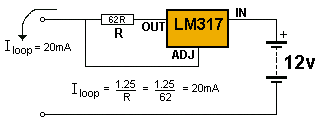 |
|
ADJUSTABLE VOLTAGE AND CURRENT LIMITING
The single regulator in this circuit will provide a variable voltage from 1.225v to 12v or more, depending on the voltage of the plug pack and the zener diode. The current will also depend on the rating of the plug pack.
|
|
MAINS DETECTOR This circuit will detect active mains at 15cm. Mains wiring must not be touched. Many CMOS chips can be used for this purpose. CD 4017, 4020, 4040 as they all have very sensitive inputs. 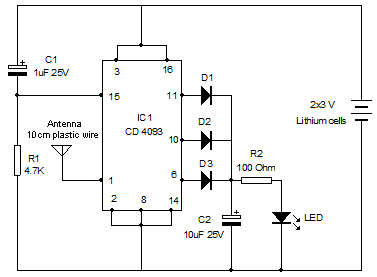 |
|
THE 74c14 IC - also known as 40106 or 40014 - it works on 5v to 15v.
The output of each gate will deliver about 10mA. This is sufficient to drive a LED, but if extra current is required, a transistor BUFFER will be needed. For up to 100mA, a BC547 can be used. For up to 4 amps a BD679 Darlington transistor can be used.
Each gate is a separate "Building Block." It is basically an AMPLIFIER. It is a CURRENT AMPLIFIER and it is different to any other type of amplifier. Here is how it works:
The next feature to understand is called THE TIME DELAY CIRCUIT
If we add the TIMING CIRCUIT (DELAY CIRCUIT) to the output of a Schmitt gate, we can see the capacitor charging and discharging:
Here is the clever part. Instead of the voltmeter monitoring the voltage across the capacitor, the input of the Schmitt Inverter can be connected to the capacitor.
Here are the basic oscillator blocks for a 74C14 (40106) IC:
An oscillator is created by placing a resistor from output to input and a capacitor from input to 0v. The output will be a square-wave and and the mark (high) will be equal to the space (low).
In figure C the output is output is low for a short period of time as the two resistors R1 and R2 are discharging the capacitor. If R2 is a very low value compared with R1 we can get the low duration to be 10% or less, of the HIGH.
Delay
If a diode is added across the input resistor, the capacitor "C" will be discharged when the input goes low, so the "Delay Time" will be instantly available when the input goes HIGH:
Pulse
To invert the output, add an inverter:
To produce a pulse after a delay, the following circuit is required:
Gating
When the push-button is pressed, the input of the first gate goes LOW and the output goes HIGH. The high from the diode prevents the capacitor discharging via the oscillator and it is "jammed" or "frozen" with the output LOW. The following circuit produces a tone for a short period of time as determined by the pulse section. When the output of the Pulse section is LOW, the oscillator will operate. When the Pulse section is HIGH the oscillator is JAMMED.
To produce a pulse of constant length, (no matter how long the button is pressed), the following circuit is needed:
To produce a TOGGLE SWITCH, the following circuit is needed.
2 MINUTE TIMER
Here is another very similar circuit. Use either the active HIGH or Active LOW switch and if the Active LOW switch is used, do not connect the parts or gate between pins 1 and 2 to the rest of the circuit.
PULSER
TRIGGER TIMER
|
|
2-SECTOR HOME ALARM This alarm circuit only has one fault. The alarm keeps wailing if the door is kept open. It only turns off after 5-10 minutes when the door is closed. The CD4093 is a quad 2-input NAND gate and each is wired as an inverter in this circuit. The first gate "A" is a timer and the output does not go HIGH until the 100u charges via the 470k. This is the Exit/Entry delay. When it goes HIGH, the two LEDs are turned ON via the 3k3 resistors. This arms the alarm. Gate "B" is an inverter that detects when the Instant input is broken and it charges the 100u via the 3k3 resistor. Gate "C" detects the charge on the 100u and turns on the BC547 transistor via the 4k7 resistor. The 100u and 4M7 provide the 5-10 minutes timer for the "wailing." The 100u and 2M2 provide the timer provide the timer for the buzzer when you enter. It will buzz for 20 seconds then turn off. If the Entry door is left open, the main siren will wail after 45 seconds. 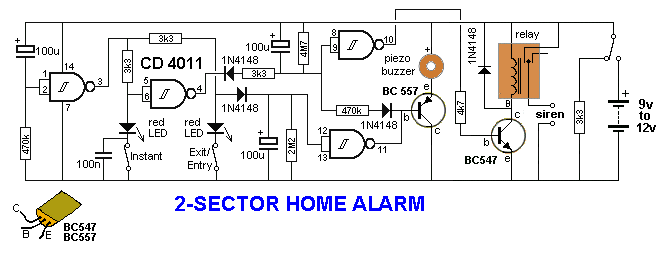 |
|
BURGLAR ALARM 4-ZONE
Build the circuit on a piece of matrix board (or the Circuit Board included in the kit) and connect the inputs to the screw terminals. 6 separate 2-screw terminals are provided in the kit to make it easy to wire-up the alarm. The alarm takes about 1mA when monitoring a house and about 100mA when activated.
POWER SUPPLY
This allows you to turn off the alarm before the loud wailing is produced and is one of the best features of the alarm as the worry of false-triggering an alarm prevents many householders setting their alarm.
The main chip contains an internal oscillator to drive a piezo diaphragm and also a wailing oscillator for the Piezo Siren. The Piezo Siren is an 80dB piezo diaphragm driven by a BD679 Darlington transistor with a 10mH choke to produce a high voltage for the diaphragm. |
|
LOGIC PROBE Kits are available for this project from Talking Electronics for $8.00 plus postage. A LOGIC PROBE is a very handy piece of equipment to have when testing a project. This project provides: High, Low, Pulse, detects a Tone and has a Signal Injection feature. You can build it in an evening on a piece of Matrix Board. 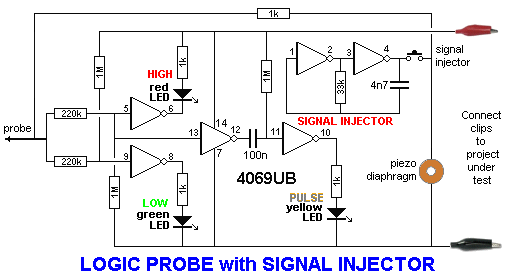  |
|
PHOER This |
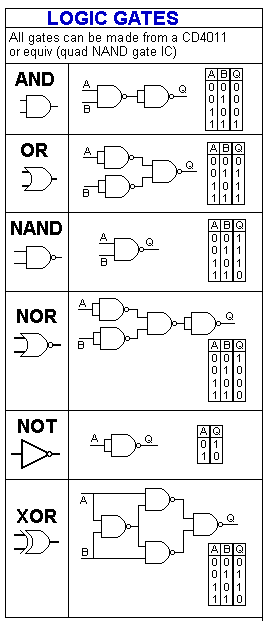 LOGIC GATES It's very handy to remember that all the logic gates can be made from a Quad NAND gate such as CD4011. |
|
Circuit Symbols
CIRCUIT SYMBOLS
Some additional symbols have been added to the following list. See Circuit Symbols on the index of |
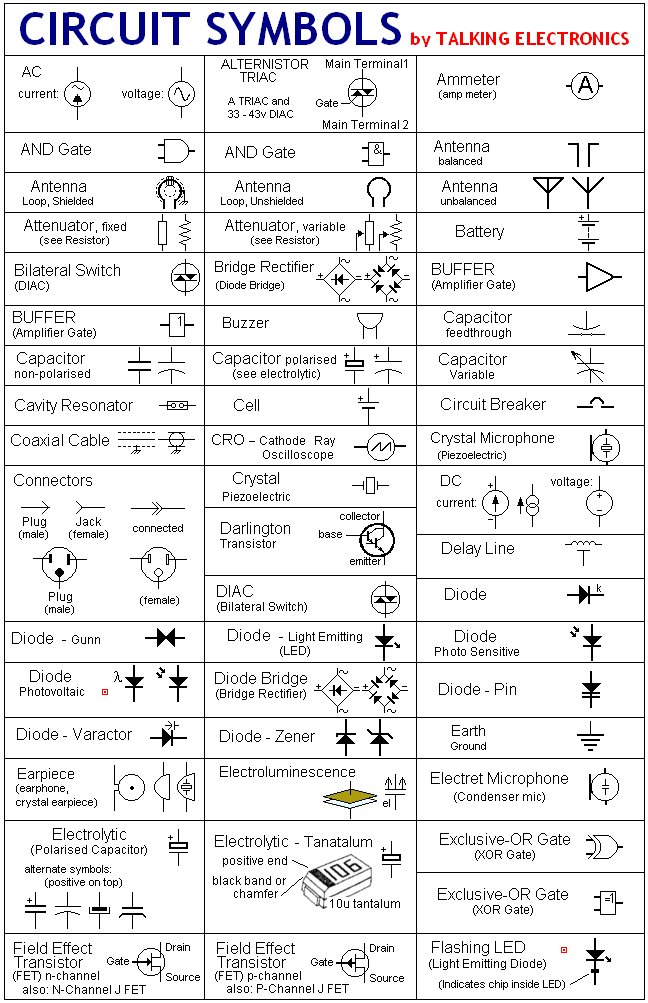
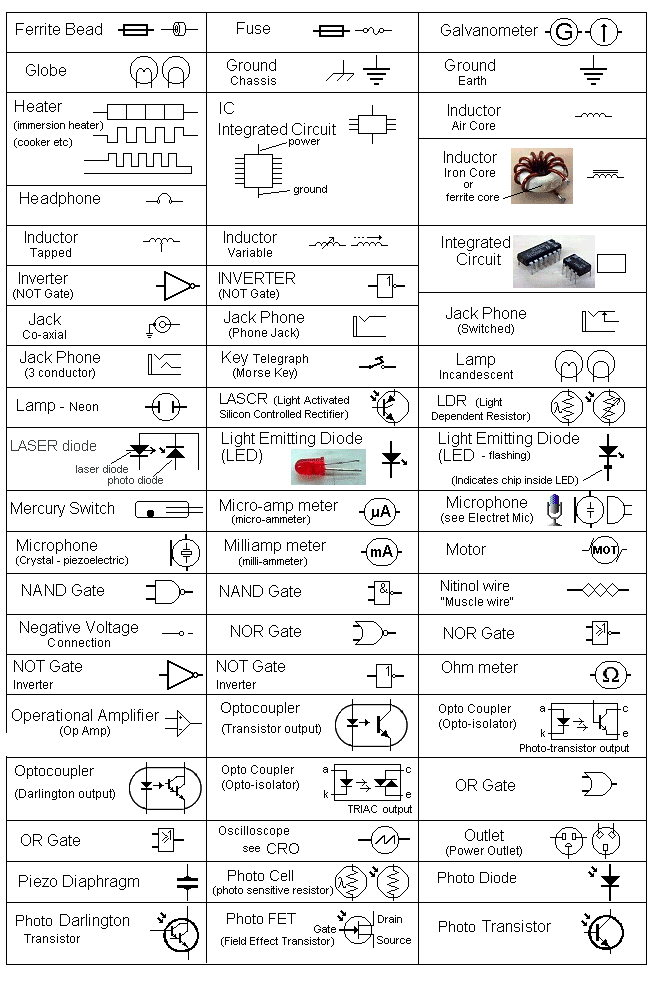
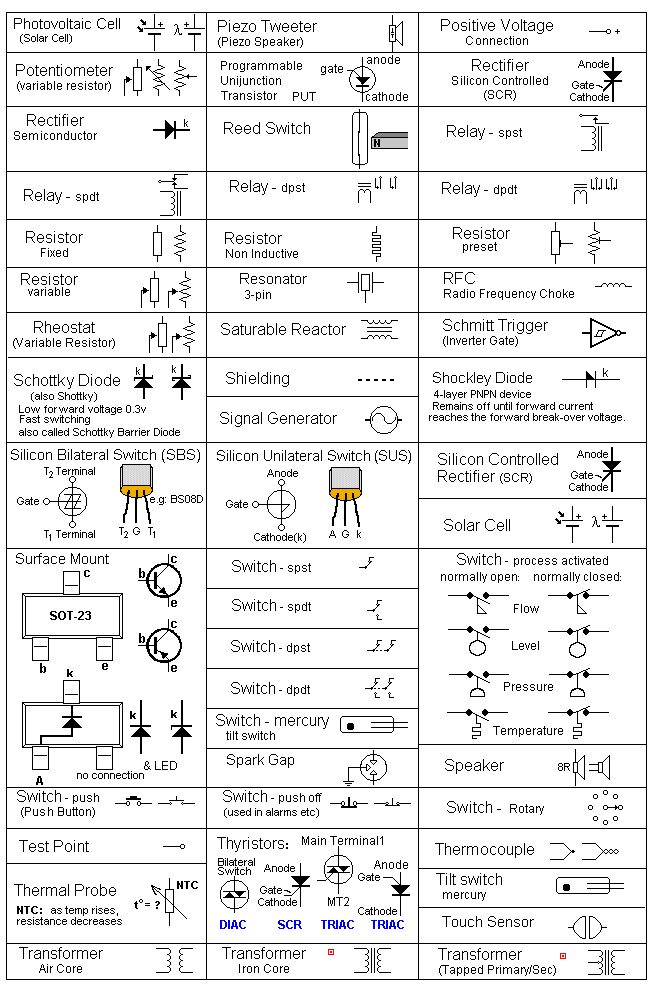
|
IC PINOUTS |
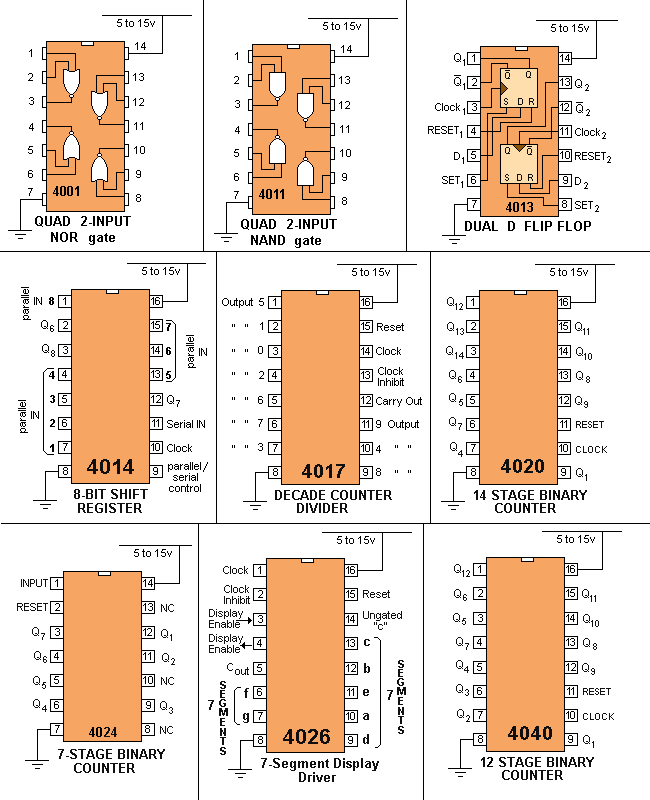
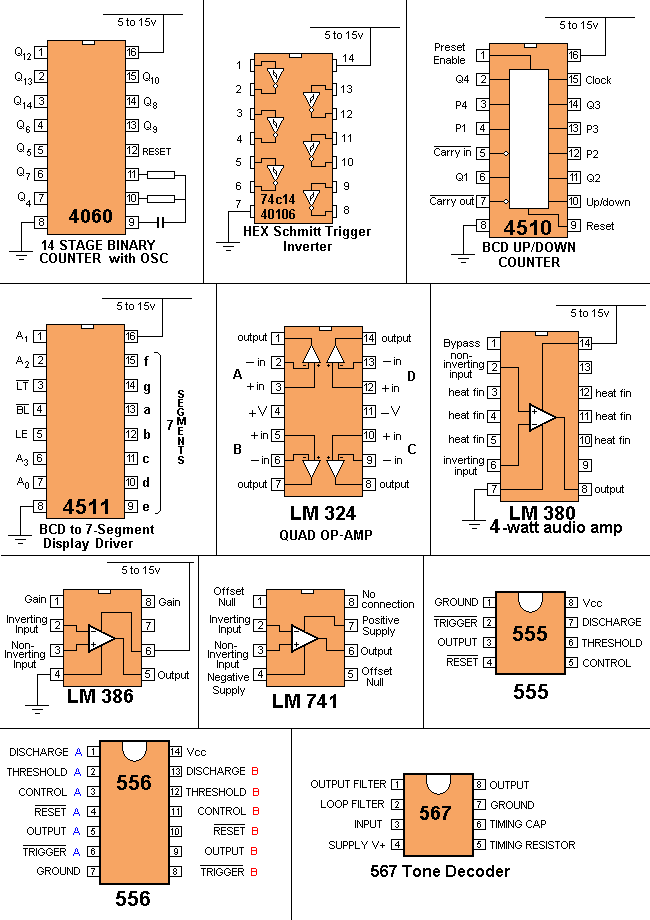
![]() to Index
to Index
All the resistor colours:
This is called the "normal" or "3 colour-band" (5%) range. If you want the 4 colour-band (1%) series, refer to
Talking Electronics website and click: Resistors 1% on the left index. Or you can use the table below.
 |
 |
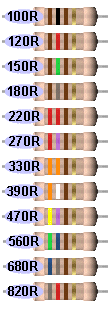 |
 |
 |
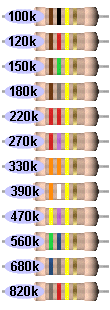 |
 |
 |
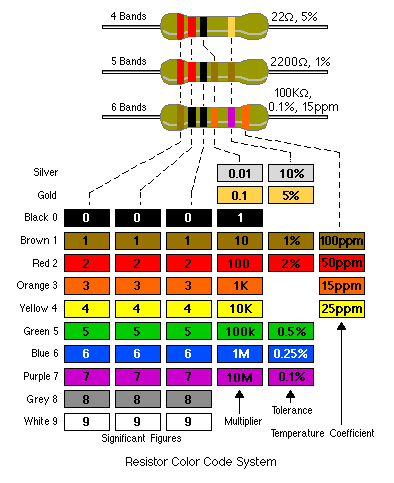
|
MAKE ANY RESISTOR VALUE:
There are other ways to combine 2 resistors in parallel or series to get a particular value. The examples above are just one way. |
|
MAKE ANY CAPACITOR VALUE:
The value "10" in the chart above can be 10p, 10n or 10u. The chart works for all decades (values). |
